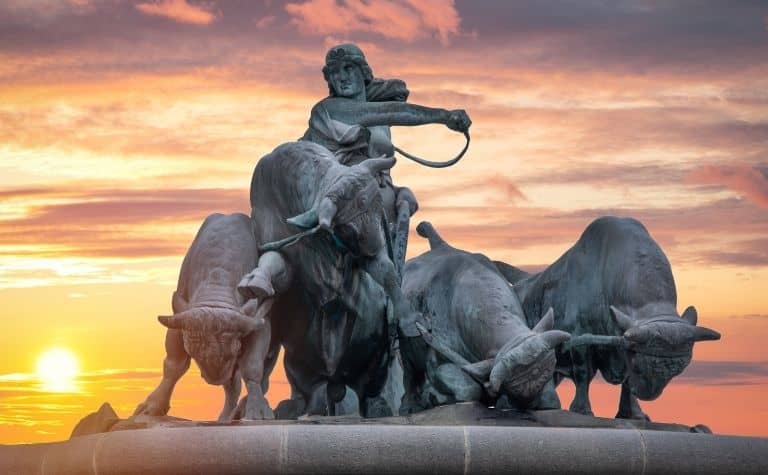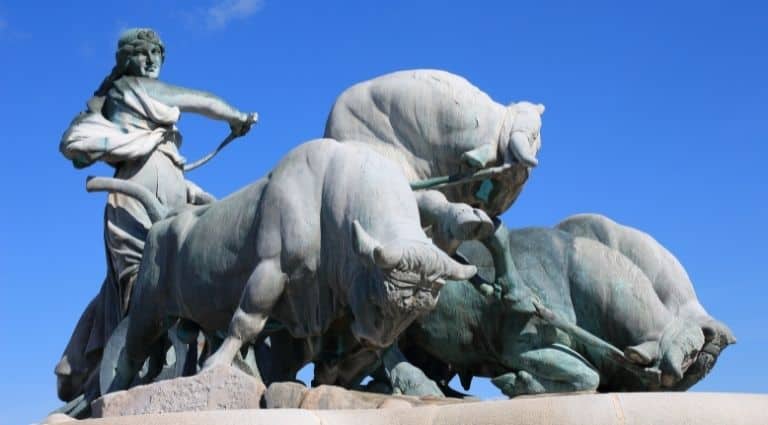In terms of popularity, names like Odin and Thor top the ranks of deities in Norse mythology. Expand these categories to include infamy and disrepute, and the god of mischief Loki tops the list.
But in terms of gods and goddesses who have the greatest impact not only on their worshippers but also their peers and adversaries, the Norse goddess Freyja more than holds her own against her more famous brethren.
Freyja is the Norse goddess of love, witchcraft, and war, among other things.
With such a broad range of human (and godly) realms under her dominion, Freyja is looked to for matters ranging from marriage to fortune-telling to the afterlife. And in some respects, her powers even exceed those of Odin.
As evidenced by her immense popularity among the ancient Norse people (including none other than the Vikings) and the numerous mythological tales in which she plays a central role, Freyja is a larger-than-life figure in her own right with her own following of worshippers.
Although she has cemented her place among the elite Norse deities, questions about her true identity still remain. Keep reading, as we explain more below.

Who is Freyja in Norse Mythology?
Unlike the all-father Odin and the god of thunder Thor, who belong to the more prominent Aesir clan of Norse gods, Freyja is by birth a member of their rival deity group, the Vanir gods. (Also see 25 Norse Gods to Know)
The conflict between the Aesirs and Vanirs was hostile, to say the least, and rooted in fundamental dissimilarities in behavior and customs (for instance, the Vanirs practiced incest, which the Aesirs viewed with disapproval).
As the warring factions settled their long-held differences, Freyja, her twin brother Freyr, and their father Njord were sent from the Vanir side over to the Aesirs as collateral of sorts.
And they were soon accepted by their new comrades as their own. The offspring of the god of the sea and goddess of the earth, Freyja is described as possessing beauty beyond compare, with no peer in the entire universe. [1]
Physical appearance aside, in matters relating to fate, sorcery, love, war, and even death, Freyja is the deity that worshipers turned to for divine intervention and providence.
She is, without argument, the most powerful and revered goddess worshiped by the Norse people.
Like many members of the Norse pantheon of gods and goddesses, Freyja (which translates to “Lady” in Old Norse) goes by many names, including:
- Freya
- Freya
- Freja
- Freyia
- Froja
- Frojya
Regardless of the particular moniker, Freyja’s prominence in Norse mythology cannot be overstated. [2]
Also, see 10 Goddesses in Norse Mythology That You Need to Know

Did the Vikings Believe Freyja was a Goddess?
The Vikings not only believed that Freyja was a goddess, but a rather powerful one, and in one very significant respect, her powers were on par, or even superior to, gods like Odin and Thor. [3] (Also see Did the Vikings Worship Odin?)
As an adopted member of her new clan, Freyja was embraced by the Aesir gods and became a beloved and respected cohort among their esteemed ranks.
In this capacity, they turned to her to teach them the ways of seidr.
One of the strongest themes running throughout Norse mythology is the interweaving of fate and destiny in the existence of every living being in the universe, gods included.
Seidr entails the use of ancient magic and shamanism to alter the path of destiny by weaving in new events or circumstances through incantations and other paranormal activities. (Also see Norse Mythology vs Greek Mythology: What’s the Difference?)
The black art of seidr was mastered exclusively by the Vanir gods, and Freyja and her father were the most gifted among them in this particular regard.
Freyja’s prowess as a volva (female mavin of seidr) was held in such high esteem that the Aesir gods, most notably Odin, sought her tutelage.
Seidr was practiced to bring about many different kinds of conditions and results, both beneficial and harmful, including:
- Cursing others through bad luck, illness, or other misfortune
- Healing wounds and curing illness
- Inflicting others with illness or injury
- Summoning good luck or fortune
- Turning the tide of battle against others
- Uncovering hidden objects and discovering untold secrets
With such awesome powers to be harnessed and put to use, it is easy to see why Odin was so keen on learning seidr from Freyja. [4] (Also see Is Norse Paganism Still Practiced?)
What is Freyja the Goddess Of?
Not only is Norse mythology a polytheistic belief system, meaning the worship of multiple gods and goddesses, but each deity typically has a range of powers and attributes that give him or her dominion over a multitude of matters and affairs. For instance, just to name a few, Odin is sought for concerns relating to:
- Knowledge
- Poetry
- Sacrifice
- War
In this regard, Freyja is no different. While she is best known for her unmatched expertise in the mysterious ways of seidr, Freyja is worshipped and revered by her followers for a host of other attributes as well, including:
- Bounty (as in plentiful resources)
- Fate and destiny
- Love, fertility, and lust
- War (more on this below)
- Wealth
But the one aspect of Freyja’s divine power, aside from her prowess in the ways of seidr, in which her authority is unmatched, is determining the fates of fallen Viking warriors. [5]
While Odin and his magnificent hall of the dead, Valhalla, are synonymous with the notion of heaven in the eyes of the Vikings, in actuality, they may not even have the first choice. (Also see Is Valhalla Heaven or Hell?)
According to many scholars:
- Freyja ruled over a realm of the Norse cosmos known as Folkvangr
- While it is true that half of the Viking warriors who die in battle end up in Valhalla, the other half find themselves in Folkvangr with Freyja
- It is Freyja, not Odin, who has first pick of fallen Viking warriors to join her in Folkvangr
- As the primary recruiter of elite Norse fighters, Freya was likely a common sight on battlefields, and as such, the famed Valkyries of Valhalla may very well be under her command and not Odin’s
Thus, in several key respects, namely sorcery and war, Freyja’s stature rivals that of the all-father Odin.
Also, see Do Female Vikings Go To Valhalla?
Who is Freyja to Thor, Loki, and Baldur?
Norse mythology is a mix of ancient native beliefs and those that were brought to Scandinavia by Germanic tribes pre-dating the Vikings.
As a result, many conflicting ideologies exist, including among them the true origins and identities of key figures. (Also see What Did the Vikings Look Like?)
According to a significant number of scholars and historians, not only are the Norse goddesses Freyja and Frigg (the wife of Odin) peers within the Aesir clan, these two deities are, in fact, one and the same entity. [6]
This being the case, Freyja, the goddess of sorcery, war, wealth, and other things, would also claim among her numerous titles, relationships with the following notable Norse gods:
- Baldur – Freyja/Frigg is this beloved god’s birth mother [7]
- Thor – Freyja/Frigg is the god of thunder’s stepmother (Odin fathered Thor with the giantess Jord) [8] (Also see The Giants of Norse Mythology)
- Loki – the god of mischief is often viewed as an adopted family member of Thor and Odin (his foster brother), which would make Freyja/Frigg some sort of sister figure to Loki [9]
The many figures that make up Norse mythology’s diverse cast of characters are fascinating, to say the least. Some, like the goddess Freyja, may very well be the amalgamation of two entities. (Or, it may be the other way around with a single being splitting into two distinct personalities that took on lives of their own.)
What is the Brisingamen necklace?
In some ancient sources, authors describe Freya with a necklace referred to as a Brisingamen, meaning “necklace of the Brisings.”
Mystery surrounds the the word history of “Brisings.” Some believe it’s related to the Norwegian word brisa, meaning “to shine.”
Others believe it may be related to the term Brosinga mene from the poem Beowulf.
[S]ince Hama bore off
a passage from Beowulf
to the shining city the Brosings’ necklace,
Gem-figured filigree. He gained the hatred
Of Eormanric the Goth, chose eternal reward
Literary sources mention the necklace, but not in detail. In one passage, Loki is called “the thief of Brisingamen.” In another, Loki steals the necklace from Freya.
In still another, Heimdall and Loki, as seals, fight for the necklace. In yet another passage, Heimdall is referred to as “the bringer of the necklace.”
Is there a story surrounding the necklace? Did Heimdall give Freya the necklace and then Loki stole it? Did Heimdall return the necklace to Freya after Loki had taken it?
The surviving literature doesn’t say. It mentions the necklace, but there isn’t a narrative that connects all the references to it. (Also see Can You By Genuine Viking Artifacts Today?)
What did the Brisingamen look like? The symbolism of the necklace is unclear. According to one account, the necklace depicts the Northern Lights (or aurora borealis), which symbolize warriors who have died fighting for Odin.
In another account, the necklace depicts the rising sun and is related to fertility.
Have figurines of Freya been found? Figurines of females from ancient Scandinavia have been found. The statues are unclothed but with a necklace.
Such imagery may connect the necklace to fertility in the worldview of ancient Scandinavians.
Like with other aspects of Freya’s narrative in Norse mythology, the necklace is a piece of a still-incomplete puzzle. Every piece adds to the overall picture, but there are still significant gaps in the image. (Also see How the Vikings Got Tattoos and Why)
What was Freya like?
According to ancient sources, Freya participates in battles, drives a cat-driven chariot, and reads poetry,
And Freya is the most excellent of the goddesses. She has that homestead in heaven which is called Folkvang, and wherever she rides to battle she has half the dead, and Odin half… Her hall in Sessrumnir; it is great and handsome. And when she travels, she drives her cats and sits in a carriage. She is the most accessible for people to call on, and from her name it is a sign of respect that women of substance are called ladies. She enjoys erotic poetry. It is good to call on her for love.
Gylfaginning 23
Also according to sources, Freya was married and had a daughter,
She is married to Od, and their daughter is Hnoss… Od went away on long journeys, and Freya weeps for him, and her tears are red gold. Freya has many names, and the reason for that is that she called herself by various names when she went about among unknown peoples looking for Od. She is called Mardoll and Horn, Gefn, Syr. Freya owned the Brisinga men.
Gylfaginning 34
Final Thoughts
The goddess Freyja may not have the celebrity status of Thor or Odin, but her significance in Norse mythology cannot be overstated.
An ancient writer calls her “the most beautiful and important of the goddesses.” A modern writer calls her “the most important goddess of Old Scandinavian mythology.” [10]
References:
[1] Source
[2] Source
[3] Source
[4] Source
[5] Source
[6] Source
[7] Source
[8] Source
[9] Source
[10] Dictionary of Norse Mythology by Rudolf Simek, p. 90
